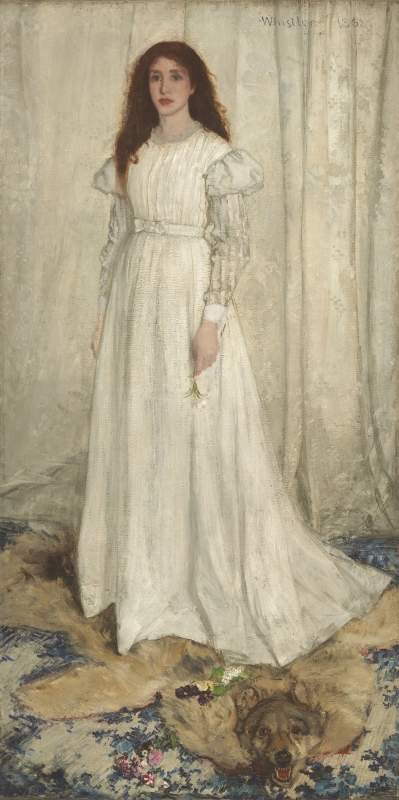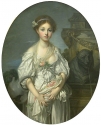Home > Catalogue > Browse > Symphony in White, No. 1: The White Girl << >>
Titles
Several titles have been suggested:
- 'femme Blanche' (1862, G. A. Lucas). 1
- 'Ye Whyte Ladye' (1862, Whistler). 2
- 'The White Girl', 'White Child' and 'WOMAN IN WHITE' (1862, Whistler). 3
- 'The Woman in White' (1862, Athenaeum). 4
- 'la Fille blanche' (1862, Whistler). 5
- 'White Girl' (1862-1863, Whistler). 6
- ' "La Fille Blanche" ' (1863, Whistler). 7
- 'Dame blanche' (1863, Salon des Refusés, Paris). 8
- 'The Woman in White' (1863, William Michael Rossett). 9
- 'The White Girl' (1867, Universal Exhibition, Paris). 10
- 'La Fille blanche' (1867, Whistler). 11
- 'White Girl' (1872, Whistler). 12
- 'A Girl in White' (1876, Baltimore Academy of Music). 13
- 'The White Girl / Symphony in White No 1' (1872/1878, Whistler). 14
- 'The Girl in the White Dress' (1876, Baltimore … Advertiser). 15
- ' "The White Girl" (Symphony in White No. 1)' (1878, Whistler). 16
- 'Symphony in White No. 1, The White Girl' (1878, Whistler). 17
- 'The White Girl' (1881, Metropolitan Museum of Art). 18
- 'Woman in White' (1881, New York newspaper). 19
- 'The White Girl' (1894-1895, Metropolitan Museum of Art). 20
- 'White Girl' (1897, Whistler). 21
- 'The Woman in White' (1898, National Academy of Design). 22
- ' "White Girl" ' (1904, Copley Society, Boston). 23
- 'The Woman in White, Symphony in White, No. 1' (1905, ISSPG). 24
- 'Symphony in White No. 1, The White Girl' (1905, Œuvres de James McNeill Whistler, Paris). 25
- 'Symphony in White, No. 1: The White Girl' (1980, YMSM). 26
'Symphony in White, No. 1: The White Girl' is the preferred title.
It is generally regarded as the first and most celebrated of Whistler's 'Symphonies in White' although it was never in fact exhibited with such a title during Whistler's lifetime.
When it was exhibited at Morgan's Gallery in Berners Street, London, in 1862, and publicised as 'The Woman in White', Whistler objected publicly to that title, stating that the painting was not an illustration of the novel of that name by Wilkie Collins (1824-1889), as implied by the art critic of The Athenaeum (probably Frederick George Stephens (1828-1907)). Whistler wrote to the editor of The Athenaeum, Frederick Dixon (d. 1923):
'The Proprietors of the Berners Street Gallery have, without my sanction, called my picture "The Woman in White." I had no intention whatsoever of illustrating Mr. Wilkie Collins's novel; it so happens, indeed, that I have never read it. My painting simply represents a girl dressed in white standing in front of a white curtain.' 27
The gallery manager, Frederick Buckstone (1837-1884), disputed Whistler's claim, saying 'Mr. Whistler was well aware of his picture being advertised as "The Woman in White", and was pleased with the name', and adding:
'There was no intention, to mislead the public by the supposition that it referred to the heroine of Mr. Wilkie Collins's novel; but being the figure of a female attired in white, with a white background, with which no-colour the artist has produced some original effects, the picture was called "The Woman in White," simply because it could not be called "The Woman in Black," or any other colour.' 28
Paul Mantz (1821-1895), writing in 1863, was the first critic to describe it as a 'Symphonie du blanc'. 29
It was not until after the exhibition of Symphony in White, No. 3 [YMSM 061] in 1867 that the three 'Symphonies' acquired their definitive titles. The original 'White Girl', Symphony in White, No. 1: The White Girl, was not actually exhibited under that title during Whistler's lifetime. Symphony in White, No. 2: The Little White Girl [YMSM 052] was only exhibited with that title in 1892. A smaller painting, The White Symphony: Three Girls [YMSM 087], exhibited under the title 'Symphony in White and Red' in 1874, did not, apparently, qualify for inclusion in the numbered sequence.
Description
A full length portrait, showing a woman with long dark red hair, clad in a white dress. The dress has a close fitting bodice with a high neck, and narrow sleeves with a puff at the shoulder. She is in slightly three-quarter view to left, and her right hand is hidden, while her left hand (with a wedding ring just visible) hangs at her side, holding a wilting flower. She is standing in front of a white curtain, on a pale buff bear-skin laid on a patterned blue carpet.
Note: the animal skin has sometimes been interpreted as a wolf-skin (for instance, when it was first exhibited in America). 30 And not without justification, one journalist described it as 'the skin of some animal unknown to zoology.' 31
Sitter
Joanna Hiffernan (b. ca 1843-d.1886), Whistler's partner and chief model throughout the 1860s, who maintained close links with the artist until her death.
In particular, she posed in white for A White Note [YMSM 044], Symphony in White, No. 2: The Little White Girl [YMSM 052], Symphony in White, No. 3 [YMSM 061], The Artist's Studio [YMSM 062], and The Artist in his Studio (Whistler in his Studio) [YMSM 063]. 32
Other models posed for Whistler's later White Girls (Harmony in White and Blue [YMSM 126], Harmony in Grey and Green: Miss Cicely Alexander [YMSM 129], Harmony in Grey and Peach Colour [YMSM 131], Arrangement in White and Black [YMSM 185], and possibly Portrait of Maud Franklin [YMSM 094]).
Comments
An influential interpretation of the subject was made by Jules Antoine Castagnary (1830-1888) in 1863, when he stated that he was sure it was not a demonstration of Whistler's painterly skills in painting white on white ('Un tour de force de votre métier de peintre, consistant à enlever des blancs sur des blancs'). Instead he suggested that the portrait represented a more important ('plus élevé') subject: a woman on the morning after her wedding ('lendemain de l'épousée'), amazed by her change from virgin to lawfully married wife.
He registered, as clues, her wide-eyed gaze and flowing hair, the curtain, behind which the husband was assumed to be asleep, and the deflowering implied by the falling petals. Finally, he drew a comparison with Greuze's painting 'la Cruche cassée ou la Jeune fille pleurant son oiseau mort', which Denis Diderot (1713-1784) had interpreted as a girl seduced by a lover. 33
Curiously, Whistler had painted a Copy after Greuze's 'La Cruche cassée' [YMSM 014] in 1857. The original was a popular work by Jean-Baptiste Greuze (1725-1805). Whistler's copy has not been located, and, although it is not known if the painting was chosen by him or his client, it is probable that the image remained part of Whistler's visual memory-bank.
A wide range of sources have been suggested as possible inspiration for the figure of 'The White Girl'. David Park Curry makes a convincing case for the influence of the secular, sexually ambivalent figure of Pierrot (Le Grand Gilles) (1718-19, Musée du Louvre) by Jean-Antoine Watteau. 34 Elizabeth Prettejohn suggests comparisons with the Virgin Mary in Immaculate Conception by Bartolomé Esteban Murillo (ca 1678, Museo del Prado) which was then in the Louvre (and disliked by Whistler). 35
Margaret MacDonald and Charles Brock discuss these and other possible sources, including contemporary paintings, such as George Frederick Watts’s statuesque Portrait of Sophia Dalrymple, Watts Gallery); a specifically Christian subject, Dante Gabriel Rossetti’s “Ecce Ancilla Domini!” (The Annunciation) (Tate Britain); and a moral, symbolic figure, Joseph Durham's statuette Chastity, exhibited at the Royal Academy in 1860. 36
Notes:
1: 1 April 1862, diary, Lucas Collection, Walters Art Gallery, Baltimore; quoted by Randall 1979 [more], pp. 130, 132.
2: Whistler to E. Edwards, [10/20 June 1862], GUW #09079.
3: Whistler to G. A. Lucas, 26 June [1862], GUW #11977.
4: Stephens, 28 June 1862 [more]; title disputed in a letter to the Editor, Whistler, 5 July 1862 [more], reprinted in Whistler 1890 [more], p. 54.
5: Whistler to Fantin-Latour, [12/19 November 1862], GUW #07952.
6: Whistler to G. A. Lucas, [19 December 1862] and 16 March [1863], GUW #09189 and #10693.
7: Whistler to Fantin-Latour, 23 March [1863], GUW #11456.
8: Ouvrage de peinture, sculpture, gravure, lithographie et architecture, refusés par le Jury de 1863, et exposés, par décision de S.M. l'Empereur, au salon annexi, Salon des Refusés, Palais des Champs-Elysées, Paris, 1863 (cat. no. 596).
10: 85th exhibition Salon de 1867, Palais des Champs Elysées, Paris, 1867 and Exposition Universelle/ Universal Exhibition, Paris, 1867, U.S.A. Section (two catalogues: cat. nos. 68 and 75 respectively).
11: Whistler to Fantin-Latour, [July/September 1867], originally dated [September 1867?], GUW #08045.
12: Whistler to A. S. Cole, [25 April 1872], GUW #09011.
13: Academy Charity Exhibition, Academy of Music, Baltimore, March 1876 (cat. no. 43).
14: Undated note, possibly written [1872/1878], on a letter from Whistler to Fantin-Latour, [15 May 1863], GUW #01081.
15: Baltimore American and Commercial Advertiser, 20 March 1876.
16: Whistler to J. A. Rose, [November 1878], GUW #08784.
17: November 1878, GUL Whistler PC 1, p. 3.
18: Loan Collection of Paintings, in the West Galleries, Metropolitan Museum of Art, New York, 1881 (cat. no. 60).
19: Anon., 'The Union League', unidentified newspaper, [10 April 1881], press cutting, GUL Whistler PC 4, p. 61.
20: Loan Collections, Metropolitan Museum of Art, New York, 1894 (cat. no. 252); Loan Collections, Metropolitan Museum of Art, New York, 1895 (cat. no. 253).
21: Whistler to T. D. Whistler, October 1897, GUW #02678.
22: Loan Exhibition of Portraits for the Benefit of the Orthopædic Hospital, National Academy of Design, New York, 1898-1899 (cat. no. 254).
23: Oil Paintings, Water Colors, Pastels and Drawings: Memorial Exhibition of the Works of Mr. J. McNeill Whistler, Copley Society, Boston, 1904 (cat. no. 71).
24: Memorial Exhibition of the Works of the late James McNeill Whistler, First President of The International Society of Sculptors, Painters and Gravers, New Gallery, Regent Street, London, 1905 (cat. no. 37).
25: Œuvres de James McNeill Whistler, Palais de l'Ecole des Beaux-Arts, Paris, 1905 (cat. no. 4).
26: YMSM 1980 [more] (cat. no. 38).
27: 1 July 1862, GUW #13149; Whistler, 5 July 1862 [more], reprinted in Whistler 1890 [more], p. 54.
28: F. Buckstone to the Editor, The Athenaeum, [18 July 1862], GUW #12979; Buckstone, 19 July 1862 [more]. On the whole affair see Spencer 1998 [more], at pp. 302–05.
29: Mantz 1863 C [more], at pp. 60-61.
30: Anon., 'Mr Whistler's Paintings,' Baltimore American and Commercial Advertiser, 20 March 1876; press cutting in GUL Whistler PC1, p. 75.
31: Anon., 'The Union League', unidentified press cutting, New York, [10 April 1881], GUL Whistler PC 4, p. 61.
33: Castagnary 1863a[more], at p. 179-80.
34: Curry 2004 [more], pp. 76-78.
35: Prettejohn 2007 [more], pp. 164-66.
36: MacDonald, Margaret F. (ed.) The Woman in White: Joanna Hiffernan and James McNeill Whistler, New Haven and Washington, 2020, pp. 20, 34, 177-78.
Last updated: 19th October 2021 by Margaret







